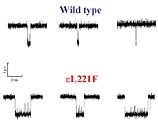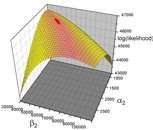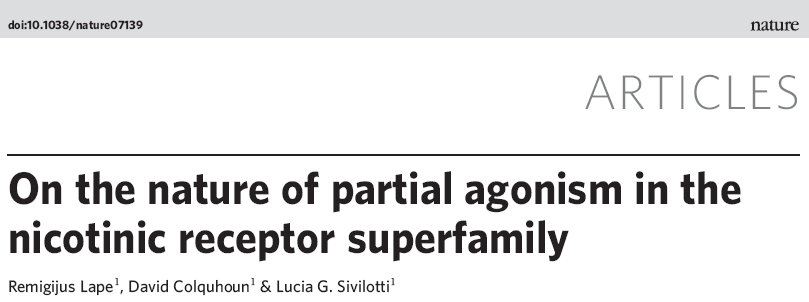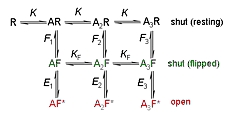
Some recent publications from the group
To download some older publications, click here.
Our work is funded by long—term grants from the Medical Research Council and the Wellcome Trust, to whom we are most grateful.


|
Some recent publications from the groupTo download some older publications, click here. Our work is funded by long—term grants from the Medical Research Council and the Wellcome Trust, to whom we are most grateful. |
 |

|
Paraskevi Krashia, Remigijus Lape, Francesco Lodesani, David Colquhoun, and Lucia G. Sivilotti. The long activations of alpha2 glycine channels can be described
by a mechanism with reaction intermediates (“flip”) Journal of General Physiology. 137, 197 – 216. [Download pdf]. Our flip model survives another test. The "flip" mechanism was introduced in Burzomato et al 2004, for alpha1-containing glycine receptors and found also to fit nicotinic acetylcholine receptors by Lape et al., 2008, who also showed that it provided an elegant description of partial agonism. This paper is about a very different glycine receptor, the homomeric alpha2 receptor. At first the flip model did not seem to describe the results, but after we realised that the very long groups of openings seen at low concentrations of glycine were actually single very long activations of the channel, everything fell inot place. The flip model provides also an elegant mechanistic description of the very long shut times between activations. |

|
Remigijus Lape, Paraskevi Krashia, David Colquhoun and Lucia G. Sivilotti (2009)) Agonist and blocking actions of choline
and tetramethylammonium on human muscle acetylcholine receptors.Journal of Physiology. 587, 5045 – 5072. [Download pdf]. Choline has been widely used as a very weak agonist iun studies of gain-of-function mutants. It is very hard to study because it blocks ion channels at concentrations lower than those needed to activate the channel, so it has taken a while to get enough results, The single channel results can be fitted on the hypothesis that choline is actually a full agonist and its reposnse is limited bu channel block rather than partial agonism. However concentration jump experiments (as well as the feeling that it is likely to be quailitatively like TMA) favour the alternative idea that choline is a very weak agonist because it is very inefficient at producing the intermediate pre-open 'flipped' conformation of the receptor. Once flipped, the channel can open and shut with similar rates to those found with acetylcholine and TMA. This interpretation is consistent with our earlier work in Burzomato et al 2004), and in Lape et al., 2008). |


|
Remigijus Lape, David Colquhoun & Lucia Sivilotti(2008) On the
nature of partial agonism in the nicotinic receptor superfamily
(2008).Nature. 454, 722 - 728. See also items about this paper on UCL News, the News and Views in Nature and Making the paper in Nature. |

|
David Colquhoun (2007) Why the Schild method is better than
Schild realised Trends in Pharmacological Sciences, 28, 608 - 614.
[email me for a reprint].
The Schild method allows genuine physical equilibrium constants for competitive antagonists to be obtained from experiments in which complex responses are measured. This paper extends work done in 1973 (here), and gives conditions under which valid results can be obtained. The Schild method may still be valid with multiple agonist binding sites, even when agonist binding sites interact and/or are not identical. |

|
David Colquhoun (2007) How to get good science. Physiology News, 69, 12 - 14,
[download the pdf]..
This is a longer version of comments published in the Times Higher Education Supplement, June 1, 2007. It concerns the bad effects of managerialism and boneheaded assesment methods on the quality, and even the honesty, of science. See also, comments on the Improbable Science blog, |
 |
Andrew J.R. Plested, Paul J Groot-Kormelink, David Colquhoun, and Lucia G Sivilotti (2007)
Single channel study of the spasmodic mutation {alpha}1A52S in recombinant rat glycine receptors. Journal of Physiology 591 (1), 51 – 73 [get pdf].
A study of the spasmodic mutation in the glycine receptor. When interpreted in terms of the 'flip' mechanism, the results suggest that the impairment of the receptor function results largely from a large reduction in the affinity of glycine for the flipped conformation, i.e. a shut conformation of the receptor that can be adopted once the ligand is bound, but precedes the opening of the channel. This removes the apparent 'cooperativity of binding', and provides a new way of looking at receptor function. This paper was accompanied by a commentary on the new proposal by Joe Henry Steinbach Joe Henry Steinbach (2007). A slip 'twixt the cup and the lip: a new way to impair function of transmitter-gated channels. [Get pdf] |
 |
Schorge, S., Elenes, S. & Colquhoun, D. (2005). Maximum likelihood fitting
of single channel NMDA activity with a mechanism composed of independent
dimers of subunits Journal of Physiology 569, 395 – 418. [Get
PDF 5.9Mb]
Our best shot at kinetic analysis of an NMDA receptor. We find an opening rate for the channel that is much faster than that found by other labs, probably because our analysis methods can detect fast shut times (see Fig. 11). |

|
Colquhoun, D. (2005). From Shut to Open: What Can We Learn from Linear Free Energy Relationships?. Biophysical Journal, 89, 3673–3675.
[Get pdf (0.1 Mb)]. This is a commentary on a paper in the same issue (Zhou, Y., J. E. Pearson, and A. Auerbach, 2005. Biophys. J. 89, 3680–3685) that attempts to use an explicit reaction scheme as an aid to interpretion of phi–analysis. Methods for detection of intermediates between resting and open states are discussed. Erratum. The allusion to unliganded gating should have cited Grosman, C. (2003), Biochemistry, 42, 14977-14987. |

|
Shelley, Chris, & Colquhoun, David (2005), A human congenital myasthenia–causing
mutation (epsilon-L78P) of the muscle nicotinic acetylcholine receptor with
unusual single channel properties Journal of Physiology, 564,
pp 377–396. Important correction. Checks carried out long after this paper was written have shown that an incorrect DNA sequence was supplied to us for this study. It happened because of mislabelling of tubes in Oxford, in 1998. Unfortunately the incorrect DNA was supplied to us at a time just before we checked everything ourselves, by end-to-end sequencing. The actual mutation used in the study was epsilonS278del, not epsilon-L78P. The results are still valid for this sequence, but the discussion of possible structural interpretations of the effects of the mutation in the paper is nonsense. Perhaps there is a valuable lesson to be learned. I have long suspected that most such structural interpretations of the functional effects of mutations are worth very little. Whatever the outcome had been, it would have been possible to write something plausible about it. Mostly it is just post hoc rationalisation. The fact of the matter is that the relationship between structure and function is only just beginning to make sense. There is a long way to go before we have much predictive ability. When someone claims otherwise, try asking them how they calculated the probability of their prediction being right by chance.[Get pdf of Corrigendum] |

|
Burzomato,Valeria; Beato,Marco; Groot–Kormelink,Paul J.; Colquhoun,David; Sivilotti,Lucia G. (2004). Single–Channel Behavior of Heteromeric a1b Glycine Receptors: An Attempt to Detect a Conformational Change before the Channel Opens. Journal of Neuroscience 24, 10924–10940. [Get PDF]
First experimental test of the flip model, in which we attempt to resolve a conformation change that occurs before the channel opens. This provides a basis for a new view of the nature of partial agonists, and the nature of agonist efficacy. |

|
 |
Colquhoun, D. (2007). Classical Perspective. What have we learned from single
ion channels? Journal of Physiology, 581, 425 – 427. [Get pdf] More (invited) navel–gazing. It starts “The only problem about being asked to write a perspective on the Colquhoun & Sakmann (1985) paper published in The Journal of Physiology is that I'm not yet sure whether the conclusions of that paper were quite right”. The 1985 paper is here. (The picture is Sakmann, dissecting, in Göttingen, 1980) |
Colquhoun, D. (2007). Perceptions of a Receptor. A book review, of Nicotinic
Acetylcholine Receptors by
Jen-Pierre Changuex and Stuart J. Edelstein. (18 Feb 2007, Science,
315, 1079) [Get pdf from Science, or download]
“I like history.
Nothing gives one a better feel for a subject than knowing how it developed.
Nicotinic Acetylcholine Receptors concentrates on the French contribution
to knowledge about these neurotransmitter receptors, and it’s a good (if,
at times, idiosyncratic) read.” . . . “The account Changeux and Edelstein
provide
in Nicotinic Acetylcholine Receptors is very good in parts. Nonetheless, as an
overall view of the current state of our understanding, it is not only incomplete
but sometimes positively misleading.”
Colquhoun, D. (2006). Playing the numbers game. A book review, of Does Measurement Measure Up? How
Numbers Reveal and Conceal the Truth by John M. Henshaw. (7 July 2006, Nature, 442, 357) [Get pdf]
“This
leads to absurd results, like university courses
in homeopathy (yes, there are some) being
given near-perfect scores when they should
really be referred to the Office of Fair Trading
for describing as science a subject that is
more akin to magic. The antics of the press in
their attempts to rank universities are a more-or-
less honest attempt to make money. The
reification imposed by the QAA is an intellectual
disgrace.”
Colquhoun, D. (2006). The quantitative analysis of drug–receptor interactions: a short history. Trends in Pharmacological Sciences, March 2006. [Get pdf]
Another short history. I was asked to write about 'receptor theory', but I dislike that term because it sounds (and often is) divorced from experimental realities, and does not distinguish between physical and empirical descriptions. This history is about 8 or 10 people who have contributed the most to physical descriptions of receptors. It traces also the origins of ideas about competitive antagonists.
Colquhoun, D. (2006). Agonist–activated ion channels. British Journal
of Pharmacology, (2006) 147, S17–S26. [Get
pdf]
This short history
looks at ion channels as an example of the pharmacologist’s stock in trade, the
action of an agonist on a receptor to produce a response.
Colquhoun, D. (2005). Stephenson, affinity and efficacy in 2005. pA2 online, volume 3 Issue 4 pp. 5–8. [Get pdf]
The death last year of Robert Stephenson provides a good excuse to take a look at the current status of his ideas, and to recall the Pharmacology department in Edinburgh in the 1960s.
DC's IMPROBABLE SCIENCE blog
This blog is the continuation
of the old IMPROBABLE SCIENCE
page.
A bad report for the vice chancellor. The Pittilo report to the Department of Health will endanger the public and
corrupt universities. There is a better way. The Times August 29th 2008 (Coomment piece)
See also comments here, and A Very bad report: gamma minus for the vice-chancellor.
Colquhoun, D. (2007) The Age of Endarkenment Guardian,
15 August.
See also the extended version of the Guardian piece, with links and comments, Science
in an age of endarkenment, This has been translated into German and Russian
UCL Lunch hour lecture. 16 October, 2007. Science in an Age of Delusions:
some examples from scientific fraud, quackery, religion and university politics
(This talk had the biggest attendeence of any of the 2007 Lunch Hour lectures.)
See
it here (needs Realplayer)
Colquhoun, D. (2007) Science degrees without the science. Nature, 446,
373 – 374. [Get pdf].
The subtitle was: "Some UK universities offer science degrees on complementary
medicine. David Colquhoun argues that these are not science but anti-science,
and asks who is too blame". This commentary piece caused something of a furore.
There were many radio and TV interviews -follow the consequences here.
Nature podcast on this topic. Download or listen to podcast. A transcript pf the podcast is here.
Today Programme (Radio 4) Interview. Download or listen to it.
Colquhoun, D. (2007) Should NICE evaluate complementary and Alternative Medicine? British Medical Journal, 337, 508 – 509. [Get pdf].
A debate in the BMJ in which the theory is advanced that the reason that CAM has still not been referred to NICE is that CAM sympathisers in the Department of Health know that it would fail. See also the comments on the debate.
Colquhoun, D. (2007) Treating Critically Ill Patients With Sugar Pills, Chest, 131, 645. [Get pdf].
This is a letter to the official journal of the American College of Chest Physicians, sent after they published an article that purported to show that homeopathic potassium dichromate (i.e. water) was a useful way to treat patients in intensive care. No, that is not a joke!
Colquhoun, D. (2005) Homoepathy: a relict ot the past. Focus Altern. Complement.
Ther. 2005; 10: 278–80. [Get
PDF]
This is a contribtion to a debate in Edzard Ernst's journal, Homoeopathy: relic of the past or medicine of the future? (Marking Samuel Hahnemann’s 250th anniversary). It proposes that homeopathy is but one example of a wider fashion for delusional behaviour.
Colquhoun, D. (2005) Abuse of Prisoners at Abu Ghraib. Science 307,1873. [Get
PDF] [Get PDF of Fiske et al.]
A letter that, along with three others, was published as a response to an article by Fiske et al. that appeared to defend Abu Ghraib behaviour as 'normal'.
Colquhoun, D. ( 2004) Too Many 'Omics (letter). The Scientist Volume 19 | Issue 3 | 8 | Feb. 14,
[Get PDF]
Latest news: is this the craziest example yet? The "Resourceome" —"the
full set of bioinformatics resources". For this one you can blame Nicola
Cannata, Emanuela Merelli and Russ B. Altman .
What Inspired You? A survey by Spiked-Online.
Yet more navel-gazing by the elderly.
David Colquhoun, Kathryn Dowsland, Marco Beato and Andrew Plested. (2004). How to impose microscopic reversibility in complex reaction mechanisms. (with appendix by Kathryn. A. Dowsland and Frank G. Ball)
Biophysical Journal, 86, 3510–3518. [Get PDF]
This paper describes three different methods for ensuring that microscopic reversibility is obeyed. Note that the method given in appendix 2 of this paper is the same as that used in the current version of the MIL program in the QUB suite (Qin, personal communication, and Qin et al 1996))
David Colquhoun and Lucia G. Sivilotti (2004). Function and structure in glycine receptors and some of their relatives. Trends in Neurosciences, 27, 337–344. [Get PDF]

|
Beato, M., Groot–Kormelink, P. J., Colquhoun, D., & Sivilotti, L. G. (2004). The activation mechanism of a1 homomeric glycine receptors. Journal of Neuroscience, 24, 895–906.
This Week in the Journal (comment by Journal of Neuroscience) | [Get PDF] |
Colquhoun, D. ( 2003) Debate: UK government funds CAM research Focus on Alternative and Complementary Therapies , 8, 397–401 (DC's bit, pp 400–401). [Get PDF]
Colquhoun, D. ( 2003) Challenging the tyranny of impact factors Nature 423, 479. [Get PDF]

|
Professor Sir Bernard Katz. Biophysicist who arrived in England with £4 and went on to win a Nobel Prize (Obituary) Independent 26 April 2003 [Get PDF] or reproduction of Newspaper version |
Professor Sir Bernard Katz. A longer account of his life from Physiology News (Autumn 2003, number 52, pp 34–38) [Get PDF]
Inside front cover (portrait) [Get PDF]
Inside back cover (scenes from BK's life) [Get PDF]

|
Colquhoun, D., Hatton, C., & Hawkes, A. G. ( 2003) The quality of maximum likelihood estimation of ion channel rate constants . Journal of Physiology (London) 547, 699–728. [Get PDF]
A study of the ability of the HJCFIT method to extract rate constants for a reaction mechanism from a sequence of open and shut times. |

|
Hatton, C., Shelley, C., Brydson, M., Beeson, D., & Colquhoun, D. ( 2003) Properties of the human muscle nicotinic receptor, and of the slow–channel syndrome mutant eL221F, inferred from maximum likelihood fits. Journal of Physiology (London) 547, 729-760. [Get PDF]
Application of the HJCFIT method to wild type nicotinic receptors, and to a disease–causing mutant. |
Colquhoun, D., Unwin, N., Shelley, C., Hatton, C. J., & Sivilotti, L. ( 2003) Nicotinic Acetylcholine Receptors. Abrahams, D. 6th Edition, Vol 2: Drug Discovery and Drug Development, Chapter 11, 357–405. New York, John Wiley. Burger's Medicinal Chemistry.
[Get PDF]
A review of the relationship between structure and function in nicotinic receptors.

|
Schorge, S. & Colquhoun, D. (2003). Studies of NMDA receptor function and stoichiometry with truncated and tandem subunits. Journal of Neuroscience 23, 1151–1158 [Get PDF]
A study with tandem constructs. The results suggest that the order of the subunits in NMDA receptor is NR1–NR1–NR2–NR2, perhaps because it is a dimer made of one NR1 dimer and and NR2 dimer. |
Beato,M.; Groot–Kormelink,P.J.; Colquhoun,D.; Sivilotti,L.G. (2002) Openings of the Rat Recombinant a1 Homomeric Glycine Receptor as a Function of the Number of Agonist Molecules Bound. J.Gen.Physiol 119, 443–466.[Get PDF]
Harry B Smith. (2002) An Uncommon Scientist with a Lot of Common Sense Molecular Interventions 2, 128–131.
[Abstract] (The link in the abstract is now wrong; click here)
[Get PDF]
This is an interview with DC —not to be taken seriously.
David Bradley (2001) Interview with David Colquhoun, HMS Beagle Issue 109.
[Get PDF ]
Another interview, another chance to sound off about science.
Hatton, C., Chen, J., Shelley, C., Croxen, R., Beeson, D., & Colquhoun, D. The defect in a slow channel myasthenic syndrome mutant , eL221F (2000) Journal of Physiology , 527P, 110P [view text] [Get PDF]
Anson, L.C., Schoepfer, R., Colquhoun, D., Wyllie, D.J.A.. Single–channel analysis of an NMDA receptor possessing a mutation in the region of the glutamate binding site (2000), Journal of Physiology (London) , 527, 225–237.
The mutant NMDA receptor, NR1a/NR2A(T671A) (see Anson et al., 1998), produces responses to 1 ms pulses of glutamate that decay more rapidly than wild type. The results support the idea that the mutation reduces the affinity of the resting state for glutamate. Also a new way of displaying geometric distributions is suggested, and the utility of a modified definition of the 'probability of being open within a burst' is discussed.
[Abstract]
[Get PDF]
Cheffings, C. and Colquhoun, D. (2000). ) Single Channel analysis of a novel NMDA channel from Xenopus oocytes expressing recombinant NR1a, NR2A and NR2D subunits, Journal of Physiology (London) , 526, 481–491. [Get PDF]
Jian Chen, David Beeson, Claire Newland and David Colquhoun (1999). ) Human muscle nicotinic receptor mechanisms, Journal of Physiology , 518P, 113P [view text] [Get PDF]
Colquhoun, D. (1999). ) GABA and the single oocyte: relating binding to gating (News & Views), Nature Neuroscience , 2, 201–202. [Get PDF]
Colquhoun, D. (1998). Binding, gating, affinity and efficacy. The interpretation
of structure–activity relationships for agonists and of the effects of mutating
receptors British Journal
of Pharmacology , 125, 923–948.
[Get PDF]
A review that attempts to bring together the classical pharmacological ideas of 'affinity' and 'efficacy', with the 'binding–gating' problem that arises whenever binding of a ligand causes a conformation change in a protein .
 |
Wyllie, D. J. A., Béhé, P. & Colquhoun, D. (1998). Single–channel activations and
concentration jumps: comparison of recombinant NR1a/NR2A and NR1a/NR2D NMDA receptors. Journal of Physiology (London) , 510, 1–18. This paper gives the general theoretical relationship, for any Markov mechanism, between the shape of macroscopic currents and the properties of the underlying bursts of single channel openings, and tests the predicted relationship experimentally on NMDA receptors. [Abstract] [Get PDF] |
 |
Groot–Kormelink, P. J., Luyten, W. H. M. L., Colquhoun, D. & Sivilotti, L. G. (1998). A reporter mutation approach shows incorporation of the 'orphan' subunit b3 into a functional nicotinic receptor. Journal of Biological Chemistry, 273 , 15317–15320. [Abstract] [Get PDF] |
Colquhoun, D. & Sakmann, B. (1998). From muscle endplate to brain synapses: A short history of synapses and agonist–activated ion channels. Neuron 20, 381–387. [Get PDF]
Anson, L. C., Chen, P. E., Wyllie, D. J. A., Colquhoun, D. & Schoepfer, R. (1998). Identification of amino acid residues of the NR2A subunit which control glutamate potency in recombinant NR1/NR2A NMDA receptors. Journal of Neuroscience 18, 581–598. [Abstract] [Get PDF]
Lewis, T. M., Sivilotti, L. G., Colquhoun, D., Gardiner, R. M., Schoepfer, R. & Rees, M. (1998). Properties of human glycine receptors containing the hyperekplexia mutation a 1(K276E), expressed in Xenopus oocytes. Journal of Physiology (London), 507, 25–40. [Abstract] [Get PDF]

|
Sivilotti, L., Okuse, K., Akopian, A. N., Moss, S. & Wood, J. N. (1997). A single serine residue confers tetrodotoxin insensitivity on the rat sensory–neuron–specific sodium channel SNS. FEBS Letters 409, 49–52. [Abstract] |
Lewis, T. M., Harkness, P. C., Sivilotti, L. G., Colquhoun, D. & Millar, S. (1997). The ion channel properties of a rat recombinant neuronal nicotinic receptor are dependent on the host cell type. Journal of Physiology (London) 505, 299–306. [Abstract] [Get PDF]
Sivilotti, L.G., McNeil, D. K., Lewis, T. M., Nassar, M., Schoepfer, R. & Colquhoun, D. (1997) Recombinant neuronal nicotinic receptors, expressed in Xenopus oocytes, do not resemble native receptors of the rat superior cervical ganglion Journal of Physiology (London). 500, 123–138. [Abstract] [Get PDF]
Colquhoun, D., Hawkes, A. G., Merlushkin, A. & Edmonds, B. (1997). Properties of
single ion channel currents elicited by a pulse of agonist concentration or voltage. Philosophical
Transactions of the Royal Society London (Physical Sciences) A 355,
1743–1786.
This paper describes the properties of non–stationary single channels that follow a jump, with exact (HJC) allowance for missed events. It also gives the relationship between single channel bursts and macroscopic currents (see also Wyllie et al, 1998)
[Abstract]
[Get PDF]
Wyllie, D. J. A., Béhé, P., Nassar, M., Schoepfer, R. & Colquhoun, D. (1996). Single–channel currents from recombinant NMDA NR1a/NR2D receptors expressed in Xenopus oocytes. Proceedings of the Royal Society London B 263, 1079–1086. [Abstract]
Akopian, A. N., Sivilotti, L. & Wood, J. N. (1996). A tetrodotoxin–resistant voltage–gated sodium channel expressed by sensory neurons. Nature 379, 257–262.[Abstract]
Silver, R. A., Colquhoun, D., Cull–Candy, S. G. , Edmonds, B. (1996). Deactivation and desensitization of non–NMDA receptors in patches and the time course of EPSCs in rat cerebellar granule cells. J. Physiol. (Lond.), 493, 167–173. [Abstract]
Colquhoun, D., Hawkes, A. G. & Srodzinski, K. (1996). Joint distributions of apparent open times and shut times of single ion channels and the maximum likelihood fitting of mechanisms. Philosophical Transactions of the Royal Society London A 354, 2555–2590. [Abstract] [Get PDF]
Chen, C. C., Akopian, A. N., Sivilotti, L. G., Colquhoun, D., Burnstock, B. & Wood, J. N. (1995). A P2X purinoceptor expressed by a subset of sensory neurons. Nature 377, 428–431. [Abstract]
Sivilotti, L. G. & Colquhoun, D. (1995). Acetylcholine receptors: too many channels, too few functions. Science 269, 1681–1682.
Colquhoun, D. & Hawkes, A. G. (1995). Desensitization of N–methyl–D–aspartate receptors: a problem of interpretation. Proceedings of the National Academy of Sciences, USA 92, 10327–10329. [Abstract] [medline]
Béhé, P., Stern, P., Wyllie, D. J. A., Nassar, M., Schoepfer, R. & Colquhoun, D. (1995). Determination of the NMDA NR1 subunit copy number in recombinant NMDA receptors. Proceedings of the Royal Society London B 262, 205–213.[Abstract]
Hawkes, A. G., Jalali, A. & Colquhoun, D. (1990). The distributions of the apparent open times and shut times in a single channel record when brief events can not be detected. Philosophical Transactions of the Royal Society London A 332, 511–538. [Get PDF]
This paper describes the exact solution of the missed event problem, which is the basis for the HJCFIT program.
Hawkes, A. G., Jalali, A. & Colquhoun, D. (1992). Asymptotic distributions of apparent open times and shut times in a single channel record allowing for the omission of brief events. Philosophical Transactions of the Royal Society London B 337, 383–404. [Get PDF]
This paper describes a very good approximation to the exact solution of the missed event problem, which is used in the HJCFIT program, for events longer than 3 deadtimes. The asymptotic solution is a mixture of (the right number of) exponentials, with appropriate time constants and areas to describe the apparent distributions. The distribution of apparent open and shut times (HJC distributions) is not described by the classical mixture of exponentials for very short events, for which the exact solution is used.